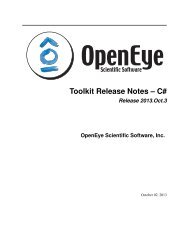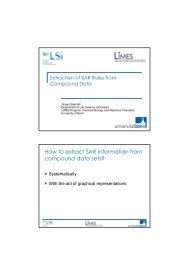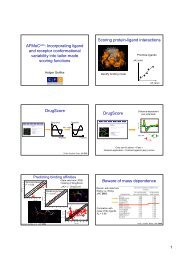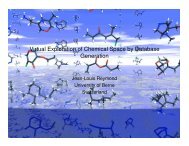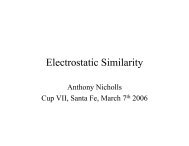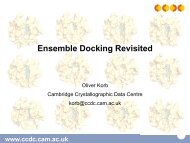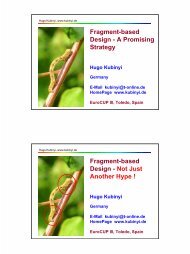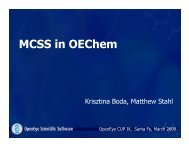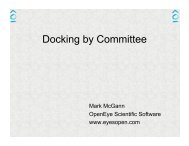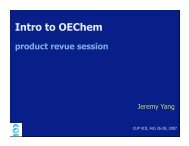OMEGA Release 2.5.1.4 OpenEye Scientific Software, Inc.
OMEGA Release 2.5.1.4 OpenEye Scientific Software, Inc.
OMEGA Release 2.5.1.4 OpenEye Scientific Software, Inc.
Create successful ePaper yourself
Turn your PDF publications into a flip-book with our unique Google optimized e-Paper software.
<strong>OMEGA</strong>, <strong>Release</strong> <strong>2.5.1.4</strong><br />
conformations produced by <strong>OMEGA</strong>. The title given to each conformer will begin with the molecule title taken<br />
from the input file, and appended with an underscore and the integer corresponding to the rank order number of<br />
the conformer in the final ensemble. [default = false]<br />
3D Construction Parameters<br />
-addfraglib<br />
The argument that follows this flag is one or more fragment files, normally generated by makefraglib. These<br />
fragments will supplement the built-in fragment library<br />
-buildff<br />
This flag sets the force field used for constructing fragments that are assembled to build an initial model of the<br />
input structure. Consult the description of Force Fields (see Force Fields) for an explanation of appropriate<br />
arguments for this flag. [default = mmff94s_NoEstat]<br />
-canonOrder<br />
This flag can be used to disable the automatic reordering of input molecules to a canonical atom and bond order.<br />
In order obtain consistent results from different file formats and different connection table orders, <strong>OMEGA</strong><br />
reorders the input connection table. This behavior can be turned off using the -canonOrder flag, however, the<br />
resultant ensembles will likely be inconsistent in their composition. [default = true]<br />
-deleteFixHydrogens<br />
When a fixfile fragment is specified, all possible mappings (matches) of the fragment and the input molecule are<br />
considered for positioning the input molecule. This process begins with a substructure search of the fragment<br />
in the input molecule. If hydrogens are included on the fixfile fragment, the number of possible matches will<br />
grow exponentially with the number of equivalences. Each geminal hydrogen pair on the fixfile produces a<br />
non-productive match multiplied by all other non-productive matches. This flag can be used to prevent the<br />
explosion of non-productive matches by deleting hydrogens from the fixfile fragment prior to the substructure<br />
search. [default = true]<br />
-dielectric<br />
The argument to this flag allows the user to specify the dielectric applied to the Coulomb term of the force field.<br />
This flag may only be used with a version of the search force field that includes the Coulomb term, such as the<br />
MMFF94 and MMFF94s variants. [default = 1.0]<br />
-exponent<br />
The argument to this flag allows the user to specify the exponent applied to the inverse distance calculation of<br />
the Coulomb term of the force field (i.e. (1/r) X where X is the argument to the -exponent flag). This flag may<br />
only be used with a version of the search force field that includes the Coulomb term, such as the MMFF94 and<br />
MMFF94s variants. The legal values are 1 or 2. [default = 1]<br />
-fixfile<br />
The argument that follows this flag is a molecule file used to specify the coordinates for a substructure of the<br />
input molecules. An initial structure is generated for every input molecule, and then a substructure search is<br />
performed using the molecule or fragment provided in the fixfile as a query molecule. Every instance of the<br />
fixed substructure found in the input molecule up to a predetermined limit (see maxmatch and umatch) is used<br />
to replace the coordinates of the atoms that match the substructure. The input molecule coordinates are aligned<br />
relative to the substructure prior to fragment replacement, and then the coordinates are taken from the fixed<br />
fragment and assigned to the corresponding atoms of the input molecule. A separate alignment, replacement,<br />
and then conformer search is carried out for every matching substructure in the input molecule. Molecules that<br />
do not match the fixfile will be sent to the fail file.<br />
-fixrms<br />
Fixfile fragments taken from crystallographic sources may differ in their geometry relative to optimal MMFF<br />
geometries. <strong>OMEGA</strong> attempts to superimpose built structures onto fixfile fragments and, if the geometry differs<br />
too greatly, <strong>OMEGA</strong> considers the superposition a poor match and will fail to build a structure using the fixfile.<br />
4.1. Command Line Interface 15



